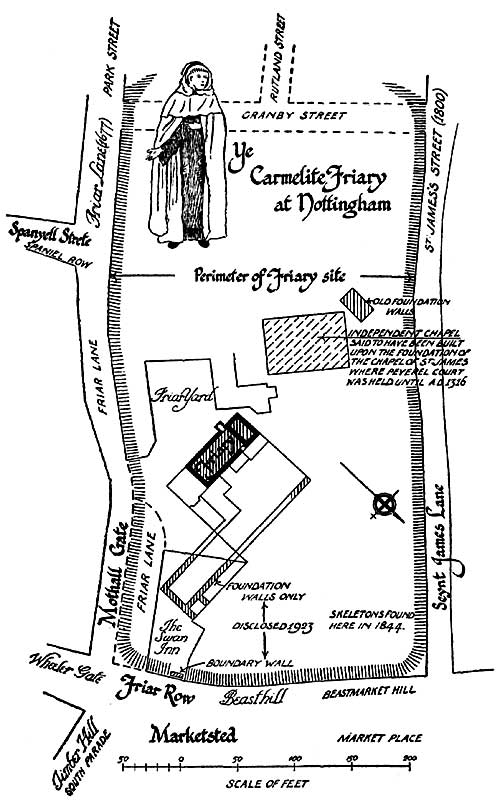Notes on the Carmelite Friary at Nottingham.
BY HARRY GILL.
IN the process of widening the narrow thoroughfare known as Friar Lane, traces of one of the old religious institutions of the town have been brought to light in the south east corner of the Market place, in Nottingham.
About two thirds of the area to be cleared was acquired by the Corporation of Nottingham for street widening purposes, and no excavation on this portion was carried out, for as soon as the old buildings had been razed to the ground, the surface of the new roadway was formed and paved. But the site of the old "Swan Inn" adjoining is to be utilised for rebuilding purposes, and it was therefore necessary to adapt this portion of the area by lowering the surface of the ground to a depth of eleven feet. Everything lying between the original surface and the bed rock was thus disclosed, viz: fragments of worked stone, glazed floor tiles, stone roofing slabs, lead piping and taps, etc., together with massive foundation walls, four feet thick, and a small portion of boundary wall, 2 feet thick, which had been left in situ.
This masonry consists of large blocks of rough hewn stone quarried from the skerry beds which underlie the clay cap on the north side of the town, with wide joints set in puddled clay. It is obvious that the bulk of this rough masonry was not intended to be in sight; it was placed there to overcome natural inequalities in the ground, and to bring up the foundation from the bed rock to the finished surface of the site. In the only place where the walling assumes its finished appearance it is brought to an average thickness of 2ft. 8ins., with an ashlar face of dressed stone both sides.
It is impossible to determine the exact nature of the superstructure that was set upon these foundation walls. The plan indicates a range of buildings 27ft. wide over all and situated 30ft. to the east of a block of old buildings now converted into offices in Friar Yard. The axis of the building runs due east and west, and there are indications of collateral set-offs.
Human skeletons have been disinterred, lying in the open space between the foundations thus exposed and the parallel buildings in Friar Yard.
From contemporary documents and charters we know that a house of Carmelites or White Friars was founded circa 1276, on a piece of land lying between Moot Hall Gate and St. James's Lane—see Plan—one of the most conspicuous sites in the medieval town ; being contiguous to and in full sight of the Market place; for the mendicant Friars, unlike the Monks, sought to establish themselves where population was densest.
A chapel dedicated to St. James built on this site for the use of the garrison of the Castle by William Peverel was subsequently granted to them by King Edward II.; but the recent discoveries could not have formed part of the King's gift, for all the remnants point to a late 14th century building, simple and unpretentious in character, corresponding in style and workmanship with contemporary parish churches in the villages round about. The glazed monastic floor tiles were evidently obtained from the Nottingham kilns and are similar to the tiles found at Lenton and Beauvale. (See Transactions, Vol. XII, plate VIII, p. 90).
The foundation walls have now been broken up and removed, and it is not likely that any further disclosure will be possible until the turn comes for the building in Friar Yard to be demolished.
A plan of a Carmelite Monastery, viz.:—Hulme, near Alnwick, probably the oldest as it is certainly the most complete plan of a house of White Friars extant, will be found in The Archaeological Journal.Vol. XLVII (1890).

